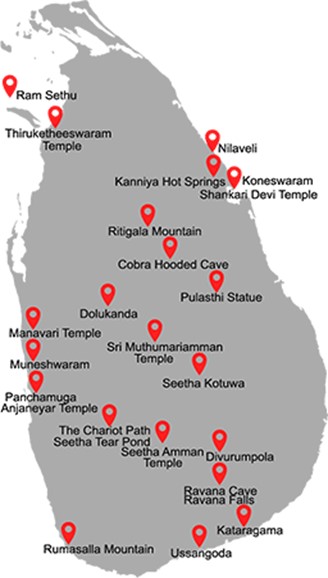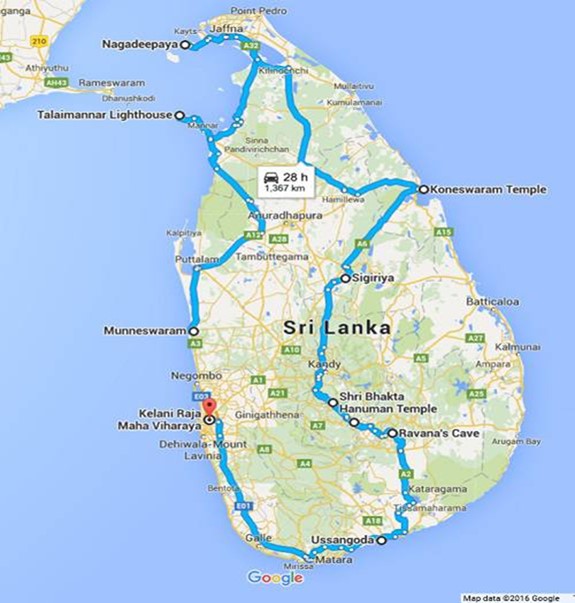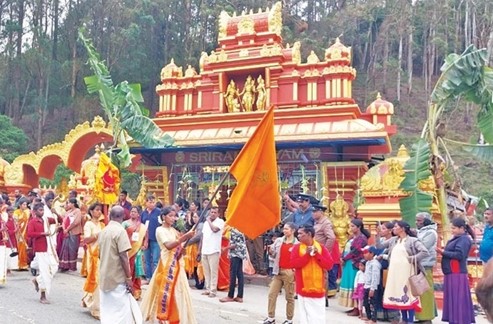BUDDHIST VIHARAS AND EELAM Part 23A
Posted on July 30th, 2024
KAMALIKA PIERIS
In this essay, I return to the topic of the Ramayana trail in Sri Lanka. The RASSL held a well attended seminar on the Ramayana trail in 2010, where many spoke against the Ramayana trail. They commented on the political implications of the Ramayana trail in Sri Lanka. They thought that the Ramayana trail was not intended to lure tourists. It was part of a bigger agenda to present Sri Lanka as a Hindu country.
Why is the Ramayana epic, which remained unacceptable in Sri Lanka for two millennia making inroads now, asked Bandu de Silva. Ramayana Trail challenges Buddhism. It takes us back to the pre Buddhist and pre Sinhala era in Sri Lanka, Bandu said.
Gaston Perera notes that Sri Lanka is using an epic from India, an epic foreign to us, to attract tourists from India. This has at least one dangerous implication. The triumph of Rama over Ravana equals India over Sri Lanka, he observed.
The local Ramayana Trail is a move to subvert our traditional history and major belief systems, said Oliver Abeynayake. There is no Ramayana trail in India. Ramayana sites are not tourist sites , they are religious sites, to be worshipped on pilgrimage. The Indian tourists will not be ordinary tourists but Hindus obsessed with the idea of the supremacy of Rama and Sita. .
Such pilgrimages can lead to violence. A confrontational situation could be created. The Hindu population in India is highly nationalist and religious and these could be used as a pretext for war. The Tamil issue was bad enough, a Hindu intervention would be worse, concluded Oliver Abeynayake.
Someone must look into this Ramayana trail, said the alarmed audience at the RASSL seminar in 2010. This is no laughing matter. Ravana and Rama sites are now put into places of local historical significance, such as Yudaganawa. This makes it political. We must stop the Tourist Board from continuing with this.
Critics wanted to know on what evidence the Tourist Board is arranging Ramayana trails in Sri Lanka. They say that before this myth gets crystallized, the validity of these sites should be examined. Sri Lanka’s past cannot be distorted merely to attract Indian tourists. Inscriptions have been defaced.
Members of a Tour Guides Association led by their President also attended the RASSL symposium. They did not speak up at the Symposium but told me later that they had serious reservation about the Ramayana trail, though they conducted Ramayana tours.
Sudath Gunasekera commented on the matter in April 2024. He pointed out that the 21 Ramayana trail sites cover the entire island. He provides two maps, one with the sites, second with the route.[1]


Sudath continued, I think it is very dangerous to allow this project, particularly in the context of Modi’s present plan of Indian territorial expansion. They may try to use this project to build up a case for amalgamation of the Island to India.
I strongly suggest These Ramayana tours should adhere to a strictly laid down pilgrimage tour program, the breach of which should be the discontinuation of the trail programme forth with. I suggest the following conditions should be included in the list of conditions to the tourists.
i.The Indian Government or any of their local agents should not put up any monuments of Rama or any god or Hindu religious symbols such as Lingas or any such buildings on any one of these spots in the guise of even pilgrim rests. They should use only facilities available in local tourist hotels.
ii.Neither the Indian Government or any one of their agents either Indian or local should be allowed to put up any religious monuments on these places as it will harm the historical local Sinhala Buddhist cultural landscape, concluded Sudath.
There is considerable evidence against a Ramayana Trail in Sri Lanka. Researchers say that the present Sri Lanka is not the Lanka of Ravana. It is not the Lanka in the Ramayana. Both India and Sri Lanka agree on that. Sri Lanka was known to Indians in the ancient period as Simhala or Tamraparni, and not as Lanka.
According to Indian archaeologist, Sankalia, Lanka is a Mundari word which means an ‘island’. People of Sonpur on the Madhya Pradesh-Andhra-Orissa border traditionally regard it as ‘Pashchim Lanka’ (western Lanka).
Critics say that neither Hanuman nor Sita ever came here and there was no Ravana either. Sita Eliya in Nuwara Eliya district has nothing to do with the Rama and Sita story. ‘Sita’ is derived from ‘seethala’, which means cold.
However, Director General of Sri Lanka Tourist Development Authority, S. Kailselvam said in 2010 it is not our job to verify historical accuracy but to encourage tourism, which is what we are doing by promoting the Ramayana trails. As long as people believe in these sites we will promote it.
The government of Sri Lanka supports the Ramayana trail. . In September 2023 As part of activities to mark the 75th anniversary of the establishment of formal diplomatic relations between India and Sri Lanka, the High Commission of Sri Lanka in New Delhi initiated a book project on Ramayana sites titled In the Footsteps of Rama; A Cultural Journey through India and Sri Lanka”. The book will feature the Ramayana sites both in India and Sri Lanka giving historical, archeological and mythological aspects of these sites.
There is Indian support for the Ramayana trail as well. Indian cultural Centre, Colombo had a seminar on Ramayana trail in Colombo. Swami Govind Dev Giri Maharaj, the Treasurer of the Shri Ram Janmabhoomi Teerth Kshetra Trust, Ayodhya, India, arrived in Sri Lanka in May 2024, accompanied by a team of delegates from Ayodhya Shri Ram Mandir to inaugurate the Ramayana trail. He was invited by President Ranil Wickremesinghe to promote religious tourism between the two countries. This brings a Hindutva link to the Ramayana Trail.
The Hindutva ideology wishes to see Hindu hegemony in India. The BJP officially adopted Hindutva as its ideology. Hindutva believe that events in Hindu mythology are true. But, there is disagreement on Hindutva in India itself. One section of India is virulently opposed to Hindutva, and that group find themselves critiquing Hinduism and Ramayana as well.
India is recognizing this slim Hindu component in Sri Lanka .Indian Prime Minister Modi was to have worshipped at Nallur, but due to practical difficulties, worshiped at another Kovil, on his Jaffna visit. Princess Anne did not visit a kovil in Jaffna on her visit here, but visited a kovil in Colombo.
Sri Lanka is now becoming more Hindu than it was before. Sri Lanka now has two sets of Hindu kovils, Siva kovils worshipped by the Ceylon Tamils and Vishnu kovils worshiped only by tourists from India. The Ramayana trail is not patronized by local Hindus. The Hindus of Sri Lanka are Saivites and they worship in Siva temples. The Ramayana trail is connected to Vishnu worship. Rama is an incarnation of Vishnu. Therefore the Ramayana trail is for Hindus from India.
The main Ramayana temples are flourishing. The Mandalabiseka religious ceremony of the Seetha Amman Kovil of Nuwara Eliya was held in 2024 with the participation of hundreds of local and foreign devotees. The ceremonies commenced with a procession carrying the offerings and statues of Rama, Seetha, Lakshmana and Hanuman, Prior to this Mandalabiseka festival, the Kumbhabhisheka festival, which is held every eight years, was held at Seetha Amman Kovil in Nuwara Eliya on May , with the participation of Hindu devotees from many countries including India and Nepal. A special stone pillar was brought to Sri Lanka from the Rama Temple in Ayodhya to place in the Seetha Amman Kovil. A stone plaque brought from Janakpur, Nepal, birthplace of Goddess Seetha, was placed in the Kovil.

Holy Hanuman temple at Wavendon Ramboda hills by Chinmaya missions of India. There were large crowds at its first anniversary, in 2002 with thousands of devotees drawn mainly from the plantations sector, the procession went with the statue of Holy Hanuman to Sita Amman Temple at Seetha eliya, where Hindu poojas were held.
The Ramayana trail project is sailing along nicely, with several ‘inaugurations’, many tour groups and varying itineraries. Agitation about Ramayan trail seems to have died down. But the agitation probably helped to halt the use of the Ramayana trail for political purposes. (Continued)
[1] https://www.lankaweb.com/news/items/2024/04/30/reference-rama-trail-by-vichara-in-todays-lankaweb-4-30-2024-i-would-like-to-make-few-comments/